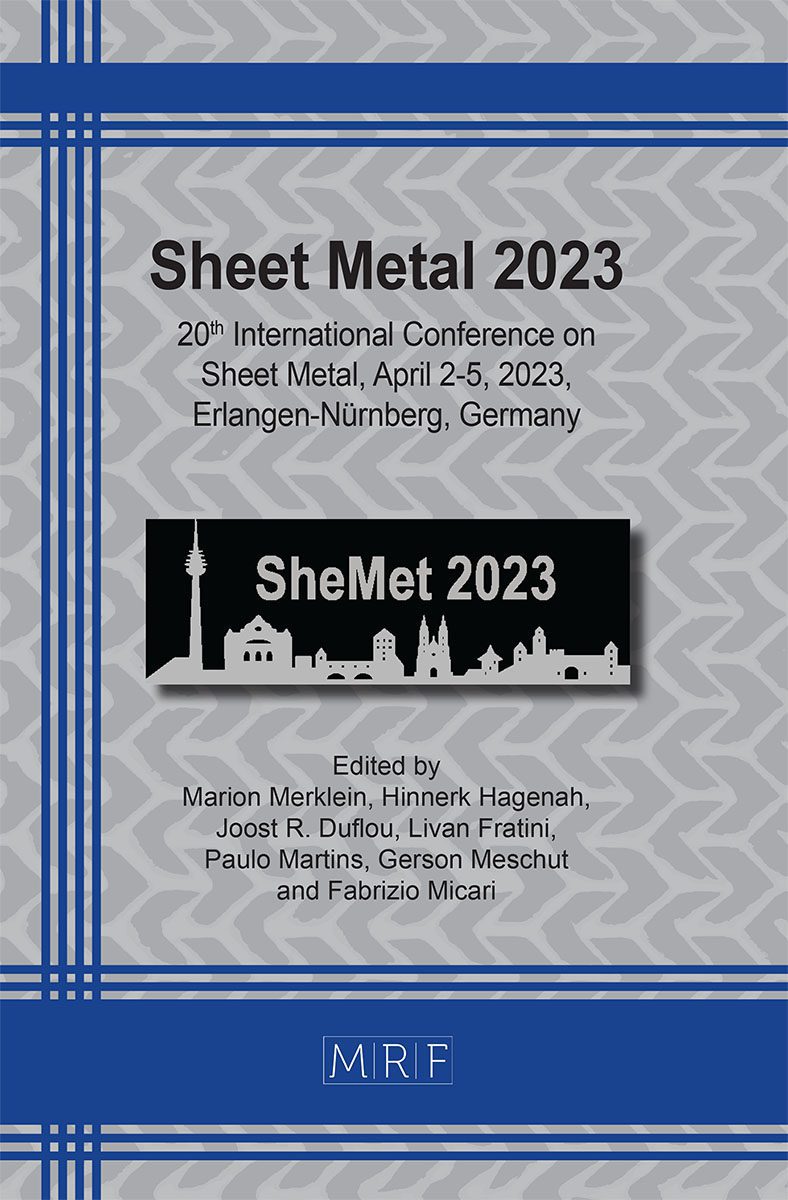A study on economic tooling concepts for dry deep-drawing using environmentally benign volatile lubricants
Gerd Reichardt, Mathias Liewald, Kim Riedmüller
download PDFAbstract. Dry processes represent promising approaches in forming technology to improve environmental aspects and human health by avoiding harmful substances and additives of conventional lubricants. Among many different approaches for dry forming investigated within the priority program SPP 1676, this paper addresses the use of volatile media as lubricants such as CO2 or N2. These volatile media are introduced directly into the interstice between sheet metal and tool surface via microinjectors. Indeed, this does not contradict the principle dry forming approach, as dry forming is defined as a process in which no residues are left on the surfaces [1]. This is ensured by the complete evaporation of the volatile media. The general feasibility of this novel tribological system has already been demonstrated in previous research work. However, despite good tribological results, the manufacturing costs of the required tool inserts and the media consumption per component are not yet economically competitive with conventional tribological systems. Therefore, this paper focuses on new designs of dry deep-drawing tools utilising volatile lubricants, considering the economics of different manufacturing processes.
Keywords
Deep Drawing, Tribology, Economic Efficiency
Published online 3/17/2023, 8 pages
Copyright © 2023 by the author(s)
Published under license by Materials Research Forum LLC., Millersville PA, USA
Citation: Gerd Reichardt, Mathias Liewald, Kim Riedmüller, A study on economic tooling concepts for dry deep-drawing using environmentally benign volatile lubricants, Materials Research Proceedings, Vol. 25, pp 405-412, 2023
DOI: https://doi.org/10.21741/9781644902417-50
The article was published as article 50 of the book Sheet Metal 2023
![]() Content from this work may be used under the terms of the Creative Commons Attribution 3.0 licence. Any further distribution of this work must maintain attribution to the author(s) and the title of the work, journal citation and DOI.
Content from this work may be used under the terms of the Creative Commons Attribution 3.0 licence. Any further distribution of this work must maintain attribution to the author(s) and the title of the work, journal citation and DOI.
References
[1] F. Vollertsen and F. Schmidt, “Dry metal forming: Definition, chances and challenges,” Int. J. Precis. Eng. Manuf. – Green Technol., vol. 1, no. 1, pp. 59–62, 2014. https://doi.org/10.1007/s40684-014-0009-0
[2] M. Liewald, C. Wörz, and K. R. Riedmüller, “Characterization of a novel aerostatic lubrication system for deep drawing processes,” CIRP Ann., vol. 70, no. 1, pp. 239–242, 2021. https://doi.org/10.1016/j.cirp.2021.03.013
[3] C. Wörz, G. Reichardt, M. Liewald, E. Zahedi, and R. Weber, “Dry deep drawing of a rectangular cup assisted by volatile media injected from laser-drilled microholes,” Dry Met. Form. OAJ FMT 4, vol. 4, pp. 1–8, 2018.
[4] G. Reichardt et al., “Friction and Wear Behavior of Deep Drawing Tools Using Volatile Lubricants Injected Through Laser-Drilled Micro-Holes,” JOM, vol. 74, no. 3, pp. 826–836, 2022. https://doi.org/10.1007/s11837-021-05028-8
[5] C. Maucher, “Test Specimens in 3D-LMF Additive Manufacturing of Special Features.” Institute for Machine Tools, University of Stuttgart, Stuttgart, 2020.
[6] G. Reichardt et al., “Tribological system for cold sheet metal forming based on volatile lubricants and laser structured surfaces,” Dry Met. Form. OAJ, vol. 6, no. Final Project Report, p. 38, 2020.
[7] R. Vollmer, “Optimierung mittels Laserauftragsschweißen hergestellter Beschichtungen für die Blechumformung,” Technischen Universität Graz, 2016.
[8] M. Kleiner and R. Krux, Entwicklung eines Verfahrens zur schnellen Herstellung von Tief- und Streckzieh Werkzeugen aus Blechlamellen für die Prototypen- und Kleinserienfertigung (Rapid Tooling), vol. P 384. Düsseldorf: Studiengesellschaft Stahlanwendungen e.V., 2001.
[9] A. Huskic, U. Giedenbacher, Jochen Pschebezin, and N. Wild, “Rapid Tooling für Umform-werkzeuge,” RTejournal, 2012.
[10] Böhler-Edelstahl, “Böhler-Edelstahl Additive Manufacturing,” Böhler W360, 2020. [Online]. Available: https://www.bohler-edelstahl.com/de/additive-manufacturing/. [Accessed: 13-May-2020].
[11] 3D-Laserdruck GbR, “Materialdatenblatt 1.2709.” 3D-Laserdruck GbR, Reutlingen, pp. 1–4, 2020.
[12] voestalpine Böhler Edelstahl GmbH, “Materialdatenblatt Böhler E185.” voestalpine Böhler Edelstahl GmbH, p. 2, 2020.
[13] Trumpf, Laser- und Systemtechnik GmbH, “Das beste Pulver für Ihre TruPrint,” TruServices Materials, 2019. [Online]. Available: www.trumpf.com/s/additivemanufacturing. [Accessed: 28-Apr-2020].
[14] H. Hoffmann, R. Neugebauer, and G. Spur, Handbuch Umformen. München: Carl Hanser Verlag, 2012. https://doi.org/10.3139/9783446430044
[15] R. Kolleck and R. Veit, “Technologien und Fertigungsmittel für die temperierte Blech-umformung,” in 13. Dresdner Werkzeugmaschinen-Fachseminar Thermisch – Thermisch unter-stützte Formprozesse, 2008.
[16] R. Kolleck, S. Pfanner, and E. . Warnke, “Development of Cooled Tools for Press Hardening of Boron Steel Sheets,” Key Eng. Mater., vol. 344, no. figure 1, pp. 225–232, 2007. https://doi.org/10.4028/www.scientific.net/KEM.344.225
[17] T. Nakagawa, “Advances in prototype and low volume sheet forming and tooling,” J. Mater. Process. Technol., vol. 98, no. 2, pp. 244–250, 2000. https://doi.org/10.1016/S0924-0136(99)00205-8
[18] A. Techel, “Lamellierte Werkzeuge im Formen- und Werkzeugbau Metal Laminated Tooling – Prozesskette zur schnellen Werkzeugfertigung (MELATO),” wt Werkstattstech. online, vol. 94, no. 11/12, pp. 663–667, 2004. https://doi.org/10.37544/1436-4980-2004-11-12-663
[19] S. Yoo and D. F. Walczyk, “Advanced design and development of profiled edge laminae tools,” J. Manuf. Process., vol. 7, no. 2, pp. 162–173, 2005. https://doi.org/10.1016/S1526-6125(05)70093-1
[20] O. Volkersen, “Die Schubkraftverteilung auf die Verbindungselemente langer Laschenver-bindungen,” Technische Hochschule Wien, 1943.
[21] M. Rasche, Handbuch Klebtechnik. Carl Hanser Verlag GmbH & Co. K, 2012. https://doi.org/10.3139/9783446431980































